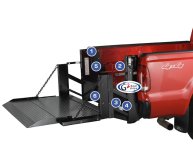SPYDERLK
Super Star Member
- Joined
- Feb 28, 2006
- Messages
- 12,525
- Location
- VA
- Tractor
- JD2010, Kubota3450,2550, Mahindra 7520 w FEL w Skid Steer QC w/Tilt Tatch, & BH, BX1500
Spyder, I'd reconsider thinking along those lines. The lift capacity is determined by a function of the weight (force) and the distance from the lift assembly, or moment (torque). You are completely discounting the moment part.
OK, so when you said "lift capacity" you meant catastrophic failure of link parts or front lift rather than pushing upward as much as the hydraulics will do at the eyes and not being able to lift something weighing that much. I had thot that was the subject. It changes when you want to talk about the required tensile and compressive strength of link elements to transfer the moment/torque into the tractor body and the required body mass distribution to resist. It certainly wasnt clear to me what you meant when you used the term in so cryptic a statement. I consider it almost a change of subject ocurring without warning on the heels of similar terms thrown about previously but referring to lift arm torque. And particularly since these links are way stronger than needed to tip a tractor back at whatever backset the required force is applied. Of course you can contrive to make them buckle or stretch if you prevent backtip by adding weight.I honestly don't know the point you're arguing. My only contention with what you said, or didn't say (originally), is you didn't mention anything about the induced moments on the 3PH. Even with a //, the moment exist and will cause a failure if the component forces in the links are allowed to grow too large. I see now (post 13?) where you mention the moments of the 3PH linkage; I missed that @ 3:30 this morning. ---I also dealt with that several other times with replys regarding your cantilever comment, general description to separate it from the hydraulics, and when I addressed a couple of your points in post 25.--- That was my original point. The lift will be limited by either the forces of the moment or the forces on the lifting links, with a // being a special case which is not realized here. If it were realized, the moment consideration still holds.
After the moment issue, I think we are on the same page.
Yes, the moment consideration as developed does hold. The misunderstanding came from me thinking you had put it into a part of the system where it was not an issue.
